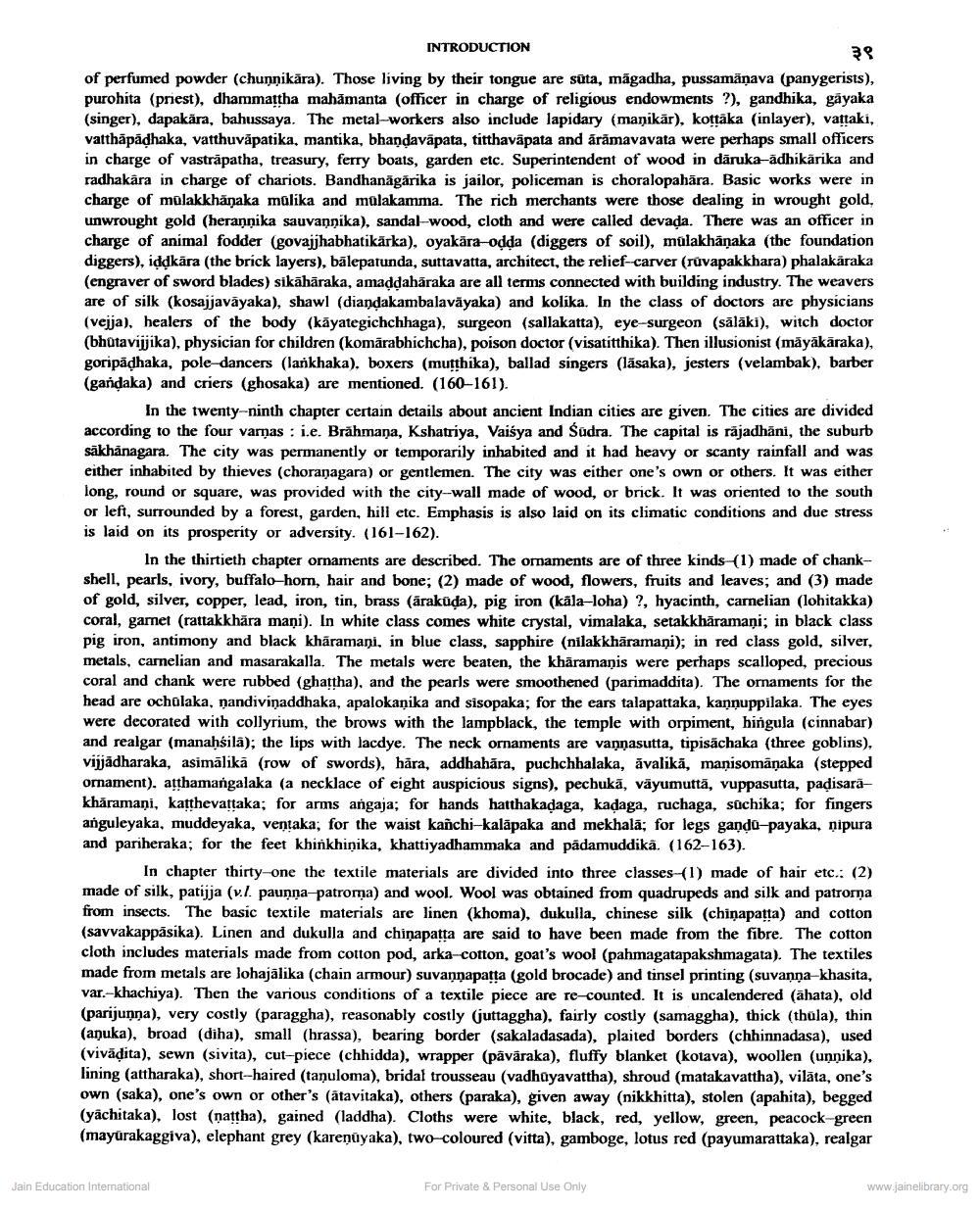________________
INTRODUCTION
३९
of perfumed powder (chuņņikára). Those living by their tongue are sūta, māgadha, pussamāņava (panygerists), purohita (priest), dhammattha mahāmanta (officer in charge of religious endowments ?), gandhika, gayaka (singer), dapakära, bahussaya. The metal-workers also include lapidary (manikär), kottaka (inlayer), vattaki, vatthāpādhaka, vatthuvāpatika, mantika, bhandavāpata, titthavāpata and ārāmavavata were perhaps small officers in charge of vastrāpatha, treasury, ferry boats, garden etc. Superintendent of wood in dāruka-adhikarika and radhakara in charge of chariots. Bandhanāgārika is jailor, policeman is choralopahāra. Basic works were in charge of mulakkhănaka malika and mulakamma. The rich merchants were those dealing in wrought gold, unwrought gold (herannika sauvannika), sandalwood, cloth and were called devada. There was an officer in charge of animal fodder (govajjhabhatikärka), oyakāra-odda (diggers of soil), mulakhāņaka (the foundation diggers), iddkāra (the brick layers), bālepatunda, suttavatta, architect, the relief-carver (Tuvapakkhara) phalakäraka (engraver of sword blades) sikāhāraka, amaddahāraka are all terms connected with building industry. The weavers are of silk (kosajjavāyaka), shawl (diandakambalavāyaka) and kolika. In the class of doctors are physicians (vejja), healers of the body (kāyategichchhaga), surgeon (sallakatta), eye-surgeon (sālāki), witch doctor (bhutavijjika), physician for children (komarabhichcha), poison doctor (visatitthika). Then illusionist (mäyäkäraka), goripādhaka, pole-dancers (larkhaka), boxers (mutthika), ballad singers (läsaka), jesters (velambak), barber (gandaka) and criers (ghosaka) are mentioned. (160-161).
In the twenty-ninth chapter certain details about ancient Indian cities are given. The cities are divided according to the four varmas : i.e. Brāhmaṇa, Kshatriya, Vaisya and Sudra. The capital is rājadhāni, the suburb sākhanagara. The city was permanently or temporarily inhabited and it had heavy or scanty rainfall and was either inhabited by thieves (choranagara) or gentlemen. The city was either one's own or others. It was either long, round or square, was provided with the city--wall made of wood, or brick. It was oriented to the south or left, surrounded by a forest, garden, hill etc. Emphasis is also laid on its climatic conditions and due stress is laid on its prosperity or adversity. (161-162).
In the thirtieth chapter ornaments are described. The ornaments are of three kinds (1) made of chankshell, pearls, ivory, buffalo-horn, hair and bone; (2) made of wood, flowers, fruits and leaves; and (3) made of gold, silver, copper, lead, iron, tin, brass (äraküda), pig iron (kala-loha) ?, hyacinth, carnelian (lohitakka) coral, garnet (rattakkhāra mani). In white class comes white crystal, vimalaka, setakkhāramani; in black class pig iron, antimony and black khāramani, in blue class, sapphire (nilakkhāramani); in red class gold, silver, metals, carnelian and masarakalla. The metals were beaten, the khäramanis were perhaps scalloped, precious coral and chank were rubbed (ghattha), and the pearls were smoothened (parimaddita). The ornaments for the head are ocholaka, nandiviņaddhaka, apalokanika and sisopaka; for the ears talapattaka, kannuppilaka. The eyes were decorated with collyrium, the brows with the lampblack, the temple with orpiment, bingula (cinnabar) and realgar (manahsila); the lips with lacdye. The neck ornaments are vannasutta, tipisāchaka (three goblins), vijjādharaka, asimālikā (row of swords), hära, addhahāra, puchchhalaka, ávalikā, manisomaņaka (stepped ornament). atthamangalaka (a necklace of eight auspicious signs), pechukā, väyumuttă, vuppasutta, padisarakhāramani, katthevattaka; for arms angaja; for hands hatthakadaga, kadaga, ruchaga, suchika; for fingers anguleyaka, muddeyaka, ventaka; for the waist kañchi-kalāpaka and mekhalā; for legs ganda payaka, nipura and pariheraka; for the feet khinkhinika, khattiyadhammaka and padamuddika. (162-163).
In chapter thirty-one the textile materials are divided into three classes -(1) made of hair etc.: (2) made of silk, patijja (v.l. paunna patrorna) and wool. Wool was obtained from quadrupeds and silk and patrorna from insects. The basic textile materials are linen (khoma), dukulla, chinese silk (chinapatta) and cotton (savvakappasika). Linen and dukulla and chiņapatta are said to have been made from the fibre. The cotton cloth includes materials made from cotton pod, arka-cotton, goat's wool (pahmagatapakshmagata). The textiles made from metals are Johajālika (chain armour) suvannapatta (gold brocade) and tinsel printing (suvanna-khasita, var.-khachiya). Then the various conditions of a textile piece are re-counted. It is uncalendered (āhata), old (parijunna), very costly (paraggha), reasonably costly juttaggha), fairly costly (samaggha), thick (thula), thin (aņuka), broad (diha), small (hrassa), bearing border (sakaladasada), plaited borders (chhinnadasa), used (vivādita), sewn (sivita), cut-piece (chhidda), wrapper (pavāraka), fluffy blanket (kotava), woollen (unnika), lining (attharaka), short--haired (tanuloma), bridal trousseau (vadhuyavattha), shroud (matakavattha), vilāta, one's own (saka), one's own or other's (atavitaka), others (paraka), given away (nikkhitta), stolen (apahita), begged (yachitaka), lost (nattha), gained (laddha). Cloths were white, black, red, yellow, green, peacock-green (mayürakaggiva), elephant grey (karenüyaka), two-coloured (vitta), gamboge, lotus red (payumarattaka), realgar
Jain Education International
For Private & Personal Use Only
www.jainelibrary.org




